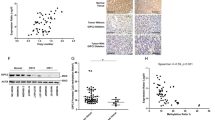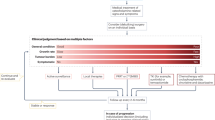Abstract
Hereditary paraganglioma is a benign tumor syndrome with an age-dependent penetrance. Carriers of germline mutations in the SDHB or SDHD genes may develop parasympathetic paragangliomas in the head and neck region or sympathetic catecholamine-secreting abdominal and thoracic paragangliomas (pheochromocytomas). In this study, we aimed to establish paraganglioma risk in 101 asymptomatic germline mutation carriers and evaluate the results of our surveillance regimen. Asymptomatic carriers of an SDHD or SDHB mutation were included once disease status was established by MRI diagnosis. Clinical surveillance revealed a head and neck paraganglioma in 28 of the 47 (59.6%) asymptomatic SDHD mutation carriers. Risk of tumor development was significantly lower in SDHB mutation carriers: 2/17 (11.8%, P=0.001). Sympathetic paragangliomas were encountered in two SDHD mutation carriers and in one SDHB mutation carrier. In conclusion, asymptomatic carriers of an SDHD mutation are at a high risk for occult parasympathetic paraganglioma. SDHB carrier risk is considerably lower, consistent with lower penetrance of SDHB mutations. For both syndromes, the risk of symptomless sympathetic paragangliomas is small.
Similar content being viewed by others
Introduction
Hereditary paraganglioma syndrome is caused by mutations in genes encoding subunits or cofactors of mitochondrial succinate dehydrogenase (SDH): SDHA, SDHB, SDHC, SDHD or SDHAF2.1, 2, 3, 4 Mutations of RET, NF1 and VHL have also been noted in rare cases of head and neck paragangliomas.5 The penetrance of SDHD-related paragangliomas is modulated by genomic imprinting, resulting in an almost complete absence of disease following maternal transmission. Paternal transmission is associated with incomplete penetrance (43–100%).6 Head and neck paragangliomas and multiple concurrent paragangliomas are most frequently observed in SDHD-linked cases, whereas extra-adrenal abdominal and thoracic (sympathetic) paragangliomas are most frequently found in SDHB-linked cases. In addition, mutations in SDHB, SDHC and SDHD, but not in SDHAF2, are associated with the development of adrenal pheochromocytomas. Malignancy, defined as metastatic paraganglioma, can occur in SDHD-linked patients but is most common in SDHB mutation carriers.7, 8 We have offered genetic testing to asymptomatic relatives of patients with SDHD mutations at Leiden University Medical Center (LUMC) since 2002, and more recently, for SDHB, SDHC or SDHAF2 mutations. We have now evaluated the outcome of SDHD/SDHB testing and surveillance, with the aim of establishing the prevalence of paragangliomas in asymptomatic carriers.
Methods
The database of the Laboratory for Diagnostic Genome Analysis (LDGA) of the Leiden University Medical Center (LUMC) was used to identify asymptomatic carriers of a known mutation in SDHD or SDHB. Subsequently, relevant clinical parameters were derived from the records of the Departments of ENT and Endocrinology (LUMC).
An MRI scan (3D/TOF with gadolinium) was considered the gold standard for diagnosis of head and neck paragangliomas. For the diagnosis of sympathetic paragangliomas, catecholamines and their 0-methylated metabolites were measured as described by Havekes et al9 and, if elevated, were followed by MRI or CT scans of the thorax and abdomen and, when positive for a suspected sympathetic paraganglioma, by MIBG-scintigraphy.
A χ2-test was used to analyze the association between mutation type and the number of parasympathetic paragangliomas. A two-sided Fisher’s exact test and a Manzel–Haenszel test were used to compare SDHD and SDHB carriers.
Results
From 2002 to 2011, 294 asymptomatic relatives underwent genetic testing, and 101 were found to carry an SDHD or SDHB mutation. An additional history taken during the first visit to the ENT clinic revealed that four subjects had existing symptoms before genetic testing and were thus excluded. Another 16 persons inherited an SDHD mutation via the maternal line and were therefore not considered to be at risk for paragangliomas. In addition, disease status could not be established in 17 cases due to a lack of MRI screening, including seven SDHB mutation carriers who declined further examination following genetic counseling.
Disease status was established in the remaining 64 asymptomatic cases, including 47 SDHD carriers and 17 SDHB carriers.
SDHD mutation carriers
Following physical examination, six of the 47 SDHD mutation carriers were suspect for head and neck paraganglioma, and the diagnosis was confirmed by MRI. An additional 22 patients carrying a total of 57 tumors (38 carotid body, 17 vagal body and 2 jugulotympanic tumors) were identified by MRI. Thus, a head and neck paraganglioma was found in 59.6% of asymptomatic SDHD carriers and multiple tumors were seen in 34%. A sympathetic paraganglioma was diagnosed in two patients (4.3%). Although the sample size was too small to show significance, individuals with c.416T>C, p.Leu139Pro mutation were affected more often, and with multiple tumors (P=0.07), compared with those with most common mutation (c.274G>T, p.Asp92Tyr) (Table 1).
A carotid body tumor was resected in three patients, two of whom showed postoperative hypoglossal nerve paresis that improved with time. In one case the superior laryngeal nerve was sacrificed and the other showed accidental accessory nerve paresis. Both patients with a sympathetic paraganglioma were treated surgically without complications.
A ‘wait and scan’ policy was adopted in the other cases, which gave the opportunity to follow the natural course of 28 tumors radiologically. Growth was observed in five tumors (17.9%) during a mean follow-up time of 3.2 (± 2.5) years. None of these patients developed symptoms during follow-up.
SDHB mutation carriers
Seventeen asymptomatic SDHB mutation carriers were investigated and MRI identified a vagal body tumor in two carriers (11.8%), significantly less than in SDHD mutation carriers (odds ratio 11.1; 2.3–54.0 95% confidence interval, P=0.001). These patients and 13 others carried the c.423+1G>A splice mutation, while the remaining two had a large deletion affecting exon 3. No association was found between the mutation and type tumor (P=0.58). An additional sympathetic paraganglioma was found in one patient and was surgically removed without complications.
Discussion
Clinical surveillance of asymptomatic SDHD mutation carriers reveals a high prevalence of occult head and neck paragangliomas, and even multiple tumors may go undetected. No sizable jugulotympanic tumors were found, probably because these tumors give rise to symptoms at an early stage. The relatively large number of affected individuals carrying the c.416T>C, p.Leu139Pro mutation suggests that this mutation may be more penetrant, but larger sample sizes will be necessary to confirm this suspicion.
In contrast to SDHD, SDHB mutations were responsible for asymptomatic head and neck tumors in only 12% of the tested cases, consistent with the low penetrance previously reported.10
The results presented here support the use of genetic testing and clinical surveillance in families with paraganglioma, not only for the exclusion of disease in genuinely healthy subjects, but also because screening allows the detection and treatment of early-stage paragangliomas. This may be particularly valid for adrenal and extra-adrenal secreting pheochromocytomas, for which surgery is recommended even in the absence of clinical signs.11 The uneventful resection of the sympathetic paragangliomas in this study underlines the fact that this is a safe procedure. In contrast, surgery of parasympathetic paragangliomas of the head and neck is associated with cranial nerve injury. These risks must be weighed against the frequently indolent natural course of the disease and a ‘wait and scan’ policy should be considered.
In conclusion, genetic testing facilitates the detection of head and neck paragangliomas in a high proportion of asymptomatic carriers and provides the opportunity to treat patients at an early stage of the disease.
References
Astuti D, Latif F, Dallol A et al. Gene mutations in the succinate dehydrogenase subunit SDHB cause susceptibility to familial pheochromocytoma and to familial paraganglioma. Am J Hum Genet 2001; 69: 49–54.
Baysal BE, Ferrell RE, Willett-Brozick JE et al. Mutations in SDHD, a mitochondrial complex II gene, in hereditary paraganglioma. Science 2000; 287: 848–851.
Hao HX, Khalimonchuk O, Schraders M et al. SDH5, a gene required for flavination of succinate dehydrogenase, is mutated in paraganglioma. Science 2009; 325: 1139–1142.
Niemann S, Muller U : Mutations in SDHC cause autosomal dominant paraganglioma, type 3. Nat Genet 2000; 26: 268–270.
Opocher G, Schiavi F : Genetics of pheochromocytomas and paragangliomas. Best Pract Res Clin Endocrinol Metab 2010; 24: 943–956.
Hensen EF, Jansen JC, Siemers MD et al. The Dutch founder mutation SDHD.D92Y shows a reduced penetrance for the development of paragangliomas in a large multigenerational family. Eur J Hum Genet 2010; 18: 62–66.
Kunst HP, Rutten MH, de Monnink JP et al. SDHAF2 (PGL2-SDH5) and hereditary head and neck paraganglioma. Clin Cancer Res 2011; 17: 247–254.
Neumann HP, Pawlu C, Peczkowska M et al. Distinct clinical features of paraganglioma syndromes associated with SDHB and SDHD gene mutations. JAMA 2004; 292: 943–951.
Havekes B, van der Klaauw AA, Weiss MM et al. Pheochromocytomas and extra-adrenal paragangliomas detected by screening in patients with SDHD-associated head-and-neck paragangliomas. Endocr Relat Cancer 2009; 16: 527–536.
Hes FJ, Weiss MM, Woortman SA et al. Low penetrance of a SDHB mutation in a large Dutch paraganglioma family. BMC Med Genet 2010; 11: 92.
NIH state-of-the-science statement on management of the clinically inapparent adrenal mass ("incidentaloma"). NIH Consens State Sci Statements 2002; 19: 1–25.
Author information
Authors and Affiliations
Corresponding author
Ethics declarations
Competing interests
The authors declare no conflict of interest.
Rights and permissions
About this article
Cite this article
Heesterman, B., Bayley, J., Tops, C. et al. High prevalence of occult paragangliomas in asymptomatic carriers of SDHD and SDHB gene mutations. Eur J Hum Genet 21, 469–470 (2013). https://doi.org/10.1038/ejhg.2012.203
Received:
Revised:
Accepted:
Published:
Issue Date:
DOI: https://doi.org/10.1038/ejhg.2012.203
Keywords
This article is cited by
-
International consensus on initial screening and follow-up of asymptomatic SDHx mutation carriers
Nature Reviews Endocrinology (2021)
-
Clinical progression and metachronous paragangliomas in a large cohort of SDHD germline variant carriers
European Journal of Human Genetics (2018)
-
Genetic and epigenetic patterns in patients with the head-and-neck paragangliomas associate with differential clinical characteristics
Journal of Cancer Research and Clinical Oncology (2017)



